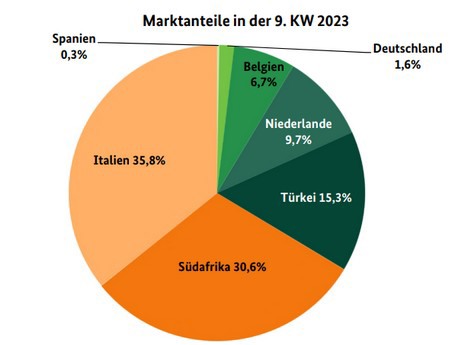The end of the European pear season was approaching: availability narrowed. Italian Abate Fetel, Williams Christ and Santa Maria continued to form the basis of the European supply, which was mainly supplemented by Conference from the Netherlands and Belgium. From the Netherlands, Xenia and Vereinsdechant pears were also dominating. Local offerings had almost completely disappeared from the market. Turkish Santa Maria rounded off the product range and cost €8 to 10 per 4.5-kg package in Berlin. According to the BLE, sales were relatively slow overall. Quality was no longer consistently convincing, which is why retailers had to give out discounts.

Imports from South Africa expanded: In addition to the omnipresent Williams Bon Chretien, there were also Cheeky, Rosemarie and Celina. The fruits generated quite a nice demand, so that sales
improved. Only products that fell too small were less noticed. The first Chilean Ercolini in 10-kg plastic crates arrived in Munich.
Apples
The week was characterized by uneventful marketing. As usual, local batches formed the basis of the assortment: Elstar, Braeburn and Golden Delicious had gained in importance, Jonagold and Holsteiner Cox lost in relevance. From Italy mainly came club varieties such as Kanzi, Jazz and Royal Gala.
Table grapes
There were no significant changes in the composition of the assortment: South African imports continued to dominate, while deliveries from Namibia and Peru completed the product range. Demand was not particularly strong and, despite slightly reduced availability, it was satisfied without any problems.
Oranges
Spanish blond oranges in the form of various Naval varieties and Salustiana continued to dominate. Shipments from Turkey, Egypt and Morocco hardly went beyond a supplementary character. Italian fruits were mostly untreated and cost between €1.30 and €1.60 per kg in Frankfurt. Demand was quite nice.
Small citrus fruits
The season was entering the home stretch: As is usual for the season, sales had become limited. Spanish Nadorcott, Tango and Orri dominated the marketing. Israeli Orri joined in. From Morocco came Nadorcott, from Turkey Murcott. Availability narrowed, yet prices remained mostly constant as demand was limited.
Lemons
Spanish Primofiori dominated the scene as usual, with Turkish Eureka and Lama following in terms of importance. Italian untreated fruits appeared only sporadically, as did Greek offerings: they were slightly discounted in Frankfurt. Overall, demand was met without difficulty.
Bananas
Business was very slow, as supply and demand harmonized sufficiently. Prices generally remained at their previous levels. Only Cologne reported slight price increases for secondary brands.
Cauliflower
French and Italian batches predominated, Turkish and Spanish were at most of a supplementary nature. Demand was not particularly strong. Moreover, as availability had expanded - French deliveries in particular had increased noticeably - it was possible to meet demand without any problems.
Lettuce
Regarding lettuce, Belgian and Italian offers predominated, with Dutch and French ones completing the scene. Business was relatively quiet. Prices crumbled in most cases as availability expanded. Iceberg lettuce saw priority access to Spanish items. Turkish and Italian batches completed the assortment.
Cucumbers
Spanish cucumbers dominated the action, with Belgian, Dutch and Greek goods complementing them. Domestic batches were available only in Munich and Frankfurt. Availability grew. Demand could not always keep pace. This meant that prices trended downwards overall.
Tomatoes
Tomatoes came mainly from Morocco, Turkey and Spain, cherry tomatoes from Italy, Spain and the Netherlands. In the case of TOVs, Turkish, Spanish and Italian deliveries could be accessed with priority. Meat tomatoes came in mainly from Turkey, Morocco and Belgium. Availability had generally increased noticeably.
Sweet peppers
Spanish and Turkish supplies predominated. Shipments from Morocco and Israel were only supplementary and sporadic. Business was mixed, with prices trending downward rather than upward overall. In Hamburg and Cologne, Spanish offers in particular were affected by the price reductions.
Source: BLE
